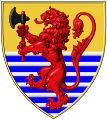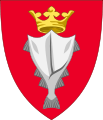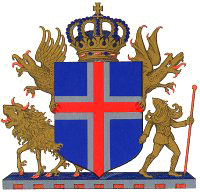The coat of arms of Iceland – monsters ahoy! Posted by hulda on Mar 5, 2015 in Icelandic culture, Icelandic history
In Medieval times Icelandic noblemen had their own coat of arms assigned to them by the ruler of the time, King of Norway, but today no Icelander is allowed to carry a personal heraldic symbol. No, not even if they can prove a family connection to the early nobles of Iceland (which, considering how small the gene pool of Iceland is, would probably make nobles out of a surprisingly large part of population anyway). There is however the national coat of arms which is considered an official symbol of Iceland.
The rules, they are so few
The reason behind the lack of coat of arms is that nobility was actually abolished in Iceland in 1660 and no office for the heraldic symbols exists here today. The national symbol of Iceland is therefore not exactly the same as coat of arms of countries usually are, it’s more like akin to a graphic design. The only rules about the appearance are:
1) The actual coat of arms is the shield in the centre filled entirely by the Icelandic flag and has to have correct proportions and colours. The cross symbolizes Christianity and the three colours are taken from the nature of Iceland: red for lava, white for glaciers and blue for the distant mountains (not sky or sea as occasionally claimed).
2) If bearers are added the shield must stand on a base of columnal basalt.
3) The bearers are the four main landvættir (= land spirits) of Iceland : Griðungur (a huge, monstrous bull), Gammur (a predatory bird, occasionally also called a griffin or a vulture), Dreki (a poison-breathing dragon – Nordic dragons don’t breathe fire) and Bergrisi (a colossal troll or a giant, the very name means mountain-giant).
How did Iceland get its coat-of-arms?
Iceland started out as a commonwealth which may or may not have had a coat of arms to itself. There is one suggestion that it would have been 12 stripes of silver and blue, but this is indeed only a suggestion based on the stripy background of another coat of arms which appeared during Norway’s reign over Iceland. When Iceland became Denmark’s colony the old symbol bearing Norway’s lion was naturally scrapped and in its stead came the Þorskmerki, cod sign.
At the beginning of the independence battle Icelanders found the Þorskmerki among the worst offenders and wanted to be rid of it. During the Danish reign Iceland was banned from trading with any other country which kept the island very, extremely poor, and dried cod was one major trade product sold to Denmark. That symbol of servitude under the crown had to go.
The gyrfalcon came next. As a symbol of Iceland gyrfalcon dates back for centuries, because for a long time some of the best hunting falcons came from Iceland! They were even called “king’s treasure” hinting at their importance and value as a gift fit for a king. The falcon lasted for about ten years but was eventually replaced by a new one.
Now we’re getting close. On this coat of arms the landvættir made their appearance, though still under a crown. Once Iceland became fully independent the crown was removed and the coat of arms re-designed to better fit the new republic that had left its previous status as a colony under monarchy. As a curious fact there’s only one place where the Danish crown was not removed – from on top of Alþingishúsið (= parliament)! It’s still there because the house was considered a gift from the king and therefore leaving the crown was deemed acceptable.
The landvættir
There were actually way more land spirits than just these four, at least going by old Icelandic texts. For example it’s written in Úlfljótur’s Law that approaching one’s home shores with “grimacing heads” at the ship front was banned by law for fear of frightening the good land spirits away. Another well-known land spirit is Bárður of Bárðar saga Snæfellsáss.
As for these four… the story starts with king Harald Gormsson of Denmark and his witch, who was sent to scout Iceland’s strength in the form of a whale. However, whenever he tried to come on land he was immediately attacked by horrifying beasts. In Vopnafjörður at northeast a dragon breathed poison on him (Dreki), on the northwest shore in Eyjafjörður he met a giant bird, or a griffin (Gammur), southwest in Breiðafjörður he saw a huge bull (Griðungur) and southeast at Vikarsskeið a giant, bearing a huge staff of iron, attacked him. Each of these monsters were flanked by numerous other spirits and so, disheartened, the witch returned to the king with bad news: Iceland was protected too well.
Skálmöld has recently released a new album called Með Vættum (= with land spirits) that builds on the original lore of the big four. Like previously the album tells a story of one person, this time of the warrior Þórunn and of her dealings with the spirits. (link) Wholeheartedly recommended!

Build vocabulary, practice pronunciation, and more with Transparent Language Online. Available anytime, anywhere, on any device.
About the Author: hulda
Hi, I'm Hulda, originally Finnish but now living in the suburbs of Reykjavík. I'm here to help you in any way I can if you're considering learning Icelandic. Nice to meet you!










